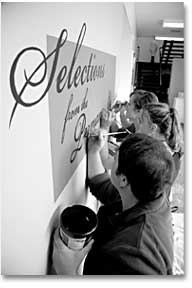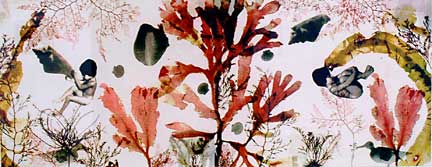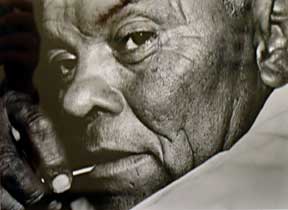|
COVER STORY | IN
THE NEWS | DIRT | ARTBEAT October 5, 2006Permanentby KATHERINE ALMY
Many permanent collections start small, with an individual or institution acquiring a few pieces of artwork. It may become a tradition to purchase one or two things a year. After a while, there are more pieces than wall space, so some things are put away. A few years down the line, somebody realizes that they're not quite sure what all the pieces are, or where they came from. This causes a bit of panic and people start furiously taking down information about the "provenance" of each piece -- where it came from, where it's been, etc. Students prepare the Reese Bullen Gallery for
its current exhibit, As the collection grows and it becomes apparent that some of it is actually worth something (and it's worth more if it's well documented), the pieces are handled with white gloves and an investment in archival storage materials might be made. Before you know it, a small institution like, say, Humboldt State University, has a collection of over 1,000 pieces. When a collection gets to this point, one might start wondering what is the point of it all if nobody sees the art. The obvious next step is to have an exhibition of "Selections from the Permanent Collection." Through Oct. 21, at the Reese Bullen Gallery on the HSU Campus, you can get a look at newly acquired or rarely seen art that is owned by the University and cared for by the students of the Art Department. A few years ago, Humboldt State started offering a certificate in Art Museum and Gallery Practices. These students "practice curatorship, registration, exhibition design and art preparation first-hand while interning with the HSU permanent collection," according to the Art Department's website. The program benefits the students who come out prepared to work in a gallery or museum, but the college benefits as well. Over the years, the students in the program have been organizing the collection, getting the records up to date, and they now have each piece photographed and listed in a database. I went to the Museum and Gallery Studies class last week to speak with the students and their instructor, Michelle McCall-Wallace, about the collection and the show. Also, of course, I went to see the exhibit, which includes recent additions from emeriti professors Tom Knight and Ellen Land-Weber. Tom Knight, who taught at HSU until his death in
1990, was hired to start the photography area within the HSU
Art Department. According to Vaughn Hutchins, instructional support
assistant in said photography area, HSU had one of the first
photography programs housed in an Art Left: Artwork by Ellen Land-Weber Ellen Land-Weber began teaching photography at HSU in 1974 and just retired in May of this year. Upon her retirement, she donated several of her works to the collection. The pieces included in this show were originally exhibited in a group show at the Los Angeles Museum of Art in 1987 called Photography and Art: Interactions since 1946 (there's a book by the same name in the HSU Library about the show, if you want to know more). Ellen told me that the pieces were created on the world's first color copy machine, which she purchased from the 3M Company in 1975 with an NEA grant. She used the machine as a camera, placing objects directly on the machine, cutting out images and collaging them together. Also included in the show are several silkscreen prints that have rarely been exhibited. Michelle isn't sure where these pieces came from, but they were included in the show because of the growing interest in printmaking on campus. "HSU used to have a really strong printmaking department, but it hasn't been the primary focus as of late," she told me -- that is, until Sarah Whorf came on board. Sarah teaches printmaking, lithography and silkscreen, and her classes are generating an increase in interest in the printmaking processes. One goal of the permanent collection is to be an educational resource, so it made sense to showcase the work of silkscreen artists for the current printmaking students.
Right: Photograph by Tom Knight. In the meantime, and in case you want to see even more of the permanent collection, the students are collecting information about the work on display at the HSU Library. A number of pieces from the collection are always on display there, and you will soon be able to read a bit about where they came from and why they are there. You can see the Library art on their website at library.humboldt.edu/art/. The Reese Bullen gallery is located in Humboldt State's Art Building directly across from the Van Duzer Theater. The gallery is open 12-5 p.m. Monday, Tuesday and Wednesday, on Thursday from 12-7 p.m., and Saturday from 10-2 p.m.
Got a local exhibit or art event that might make a good story? Send your art news to almy@arcatanet.com or write in care of the North Coast Journal, 145 South G Street, Suite A, Arcata, CA. 95521. COVER STORY | IN
THE NEWS | DIRT | ARTBEAT Comments? Write a letter! © Copyright 2006, North Coast Journal, Inc. |


 For every piece of art you see, there are
probably 10 tucked away somewhere that you don't see. Most museums,
some individuals and many kinds of institutions have permanent
collections that are, predominantly, carefully wrapped, painstakingly
documented and filed away in temperature-controlled rooms. Let's
face it, there's only so much art you can put on the walls. So
what do you do with all the rest?
For every piece of art you see, there are
probably 10 tucked away somewhere that you don't see. Most museums,
some individuals and many kinds of institutions have permanent
collections that are, predominantly, carefully wrapped, painstakingly
documented and filed away in temperature-controlled rooms. Let's
face it, there's only so much art you can put on the walls. So
what do you do with all the rest? Department.
"Prior to that," he said, "photography was usually
under the journalism or graphic arts departments." Vaughn
describes Tom as "a story-teller, and each photograph allows
the viewer to become part of the story being told." His
photographs were donated to the collection by his estate.
Department.
"Prior to that," he said, "photography was usually
under the journalism or graphic arts departments." Vaughn
describes Tom as "a story-teller, and each photograph allows
the viewer to become part of the story being told." His
photographs were donated to the collection by his estate. Every
piece of art has a story, and the stories about the artist and
how the work came to be in the collection are often as interesting
as the pieces themselves. I was hoping to see some text on the
walls telling me a little bit of this history, but was disappointed.
Researching this information is part of what the students are
doing, but for this exhibit, the information came too late to
be included. With the continuation of the process, subsequent
shows may have more historical information to accompany the work.
Every
piece of art has a story, and the stories about the artist and
how the work came to be in the collection are often as interesting
as the pieces themselves. I was hoping to see some text on the
walls telling me a little bit of this history, but was disappointed.
Researching this information is part of what the students are
doing, but for this exhibit, the information came too late to
be included. With the continuation of the process, subsequent
shows may have more historical information to accompany the work.